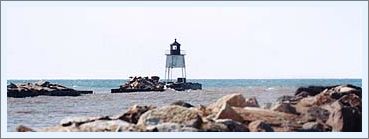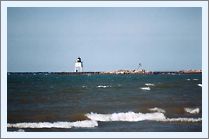|
Historical Information

With the copper boom of the 1850's, maritime traffic entering the
Ontonagon river blossomed, as vessels entered to deliver supplies to the
growing town, and departed laden with copper bound for the hungry
industries on the southern lakes. To help guide vessels into the river,
the Lighthouse Board constructed the Ontonagon lighthouse in 1853, close
to shore on the west bank of the river.
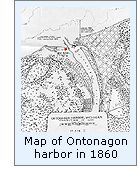 As the number of vessels entering the
river continued to grow, the Army Corps of Engineers was dispatched to
Ontonagon in 1860 to begin work on a series of harbor improvements, a
major component of which was the construction of two stone-filled timber
crib piers flanking the widened and deepened river entrance. Designed to
both still the water within the river entrance and to reduce the amount
of sand being deposited in the entry, on completion of the project the
east pier stood seven hundred feet in length, and the west pier six
hundred and fifty feet. While the Corps customarily lighted the end of
its newly constructed piers, it was determined that the diminutive
length of the piers and the proximity of the Ontonagon lighthouse made
the erection of a pierhead beacon unnecessary. As the number of vessels entering the
river continued to grow, the Army Corps of Engineers was dispatched to
Ontonagon in 1860 to begin work on a series of harbor improvements, a
major component of which was the construction of two stone-filled timber
crib piers flanking the widened and deepened river entrance. Designed to
both still the water within the river entrance and to reduce the amount
of sand being deposited in the entry, on completion of the project the
east pier stood seven hundred feet in length, and the west pier six
hundred and fifty feet. While the Corps customarily lighted the end of
its newly constructed piers, it was determined that the diminutive
length of the piers and the proximity of the Ontonagon lighthouse made
the erection of a pierhead beacon unnecessary.
With falling copper prices through the
1870's, Ontonagon's mines took the brunt, and with closure began
decaying into the thick Porcupine Mountain forests. The surrounding
forests had long been perceived as an obstacle t development by the
mining interests, their only value being as timbers to support the
stopes and drifts deep beneath the earth's surface. However, with the
cities of the southern lakes screaming for lumber to support their
phenomenal growth, the thick forests around Ontonagon were now almost
worth their weight in copper for the dying town. With the establishment
of a number of successful lumber operations, Ontonagon once again found
itself in a major boom period, and the Army Corps of Engineers returned
to undertake a series of harbor improvements to support the huge number
of lumber hookers using the harbor.
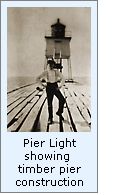 The two wooden crib piers were extended
to double their original length, and the harbor was dredged to greater
depth. With elongation of the piers, the main light was now located some
distance from the end of the piers, no longer allowing it to serve
double duty as a coast light and a guide for vessels seeking to find the
relatively narrow way between the piers. To mark the new opening in
1875, a white wooden hexagonal tower with an open frame base was erected
200 feet from the outer end of the west pier. Capped with a fixed red
Sixth Order Fresnel lens located at a focal plane of 27 feet, the light
was visible for distance of eleven miles. Responsibility for tending the
light was added to the duties of the Thomas Stripe, the keeper of the
main light, a fact which no doubt played a key role in the decision to
locate the new light on the west pier, since that was the same side on
which the main light was located, and provided Stripe with easy access
to the pierhead light. The two wooden crib piers were extended
to double their original length, and the harbor was dredged to greater
depth. With elongation of the piers, the main light was now located some
distance from the end of the piers, no longer allowing it to serve
double duty as a coast light and a guide for vessels seeking to find the
relatively narrow way between the piers. To mark the new opening in
1875, a white wooden hexagonal tower with an open frame base was erected
200 feet from the outer end of the west pier. Capped with a fixed red
Sixth Order Fresnel lens located at a focal plane of 27 feet, the light
was visible for distance of eleven miles. Responsibility for tending the
light was added to the duties of the Thomas Stripe, the keeper of the
main light, a fact which no doubt played a key role in the decision to
locate the new light on the west pier, since that was the same side on
which the main light was located, and provided Stripe with easy access
to the pierhead light.
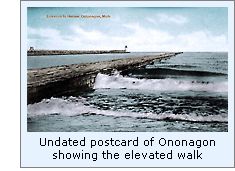 Over the ensuing years, wave action
along the outside of the western pier deposited sand along its length,
in effect moving the both the shoreline and the river mouth further out
to sea. To maintain the harbor protection, the piers were extended yet
further, leaving the light a considerable distance from the new
pierhead. Thus, in 1879 the beacon was picked up and relocated 535 feet
towards the new pierhead. This was not to be the only time that the
diminutive wooden structure took a "trip," since after further
pier extensions were undertaken in 1884, the tower was again moved 865
feet northward to the relocated pierhead. The deck height of this new
extension being 5 feet lower than the original pier to which it was
connected, a 5-foot tall elevated wooden walk was constructed from the
end of the old pier some 767 feet to the relocated light. The light's
third "trip" occurred on September 30, 1893, when after the
completion of a third extension to the piers, the structure was again
moved 378 feet to the new pierhead. Over the ensuing years, wave action
along the outside of the western pier deposited sand along its length,
in effect moving the both the shoreline and the river mouth further out
to sea. To maintain the harbor protection, the piers were extended yet
further, leaving the light a considerable distance from the new
pierhead. Thus, in 1879 the beacon was picked up and relocated 535 feet
towards the new pierhead. This was not to be the only time that the
diminutive wooden structure took a "trip," since after further
pier extensions were undertaken in 1884, the tower was again moved 865
feet northward to the relocated pierhead. The deck height of this new
extension being 5 feet lower than the original pier to which it was
connected, a 5-foot tall elevated wooden walk was constructed from the
end of the old pier some 767 feet to the relocated light. The light's
third "trip" occurred on September 30, 1893, when after the
completion of a third extension to the piers, the structure was again
moved 378 feet to the new pierhead.
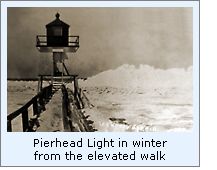 While the tower's first three trips
along the pier were carefully executed, the light's fourth
"trip" in 1899 was completely unplanned. On December 12 of
that year, a severe storm ripped the tower from its foundation bolts on
the pier and carried it away to be lost in the pounding seas. Since the
season of navigation was almost over, no steps were taken to re-light
the pierhead until April 16, 1900, when a temporary square wooden
structure with a square lantern housing a fixed red lantern light was
erected to serve until the contract for new cast iron beacon and catwalk
could be bid and filled. The beacon and materials finally arrived at the
Detroit depot on July 31, when along with a work party, they were loaded
onto the tender AMARANTH and transported to Ontonagon late that fall.
The new beacon installed and lighted for the first time on the evening
of November 10. The new structure consisted of a square steel pyramidal
frame standing 26 feet 10 inches in height, with its upper portion
enclosed to serve as shelter for the keepers working on the light. The
octagonal cast iron lantern contained a new kerosene illuminated fixed
red Fourth Order Fresnel lens with a 31 foot focal plane, effectively
increasing the light's visible range to 11 miles in clear weather. While the tower's first three trips
along the pier were carefully executed, the light's fourth
"trip" in 1899 was completely unplanned. On December 12 of
that year, a severe storm ripped the tower from its foundation bolts on
the pier and carried it away to be lost in the pounding seas. Since the
season of navigation was almost over, no steps were taken to re-light
the pierhead until April 16, 1900, when a temporary square wooden
structure with a square lantern housing a fixed red lantern light was
erected to serve until the contract for new cast iron beacon and catwalk
could be bid and filled. The beacon and materials finally arrived at the
Detroit depot on July 31, when along with a work party, they were loaded
onto the tender AMARANTH and transported to Ontonagon late that fall.
The new beacon installed and lighted for the first time on the evening
of November 10. The new structure consisted of a square steel pyramidal
frame standing 26 feet 10 inches in height, with its upper portion
enclosed to serve as shelter for the keepers working on the light. The
octagonal cast iron lantern contained a new kerosene illuminated fixed
red Fourth Order Fresnel lens with a 31 foot focal plane, effectively
increasing the light's visible range to 11 miles in clear weather.
In 1912, an electrical cable from the
city utility was run out the west pier, allowing the replacement of the
kerosene lamp with a 200 candlepower incandescent electric bulb. While
no fog signal was installed at either the pierhead or at the main light,
Corgan was provided a hand cranked fog horn with which he answered
signaling vessels with ten second blasts followed by ten seconds of
silence. By 1939, the tower was outfitted with an electrically operated
siren which emitted 3 second blasts followed by 27 seconds of silence
during period of thick weather. Activated by a switch at the main light,
the need for trips to the pierhead were virtually eliminated.
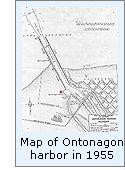 Today, both wooden piers have long been
replaced by durable concrete and rip rap structures. The east pier now
stands at an overall length of 2,315 feet, and the west pier at 2,575
feet. The west pier projects approximately 1,300 feet beyond the shore
line, which still varies in its exact location as a result of the
continually shifting sands. While maritime traffic in and out of
Ontonagon harbor has dwindled considerably, consisting mostly of private
pleasure boats and the odd freighter bringing coal to the generating
plant, the old 1900 pierhead beacon stills stands guard over the harbor
entrance. Standing forty-five feet from the end of the west pier, its
lantern is now equipped with an electric 300 mm acrylic optic showing a
2 second red flash followed by a 4 second eclipse, visibility for a
distance of 12 miles out in Lake Superior. Today, both wooden piers have long been
replaced by durable concrete and rip rap structures. The east pier now
stands at an overall length of 2,315 feet, and the west pier at 2,575
feet. The west pier projects approximately 1,300 feet beyond the shore
line, which still varies in its exact location as a result of the
continually shifting sands. While maritime traffic in and out of
Ontonagon harbor has dwindled considerably, consisting mostly of private
pleasure boats and the odd freighter bringing coal to the generating
plant, the old 1900 pierhead beacon stills stands guard over the harbor
entrance. Standing forty-five feet from the end of the west pier, its
lantern is now equipped with an electric 300 mm acrylic optic showing a
2 second red flash followed by a 4 second eclipse, visibility for a
distance of 12 miles out in Lake Superior.

Keepers of
this Light

The Ontonagon Pierhead Light was
operated and maintained by the keeper of the Ontonagon main light. Click here
to see a complete listing of all Ontonagon Light keepers compiled by
Phyllis L. Tag of Great Lakes Lighthouse Research.

Seeing this Light

We missed visiting the pierhead light during our previous trip to
Ontonagon in 1999, and so drove to Ontonagon from Bayfield on an open
afternoon during our July 2002 Apostle Islands field trip. While in
town, we also stopped by the Ontonagon Historical Society Museum, and
photographed some of the historical images of the pierhead light that
they have in their collection. The Ontonagon Museum is a great place to
spend some time, and we recommend stopping by.

Finding this Light

We
found that views of the light are difficult to obtain, since the west
pier projects from Jefferson Smurfit property, which is all fenced off.
We found a place to park near the lakeshore on the east side of town,
and walked the beach to the east pier, from which we took a couple of
photographs. We then drove to the first road that went to the lake on
the west side of town, and walked out on the beach to get some shots of
the light from a distance. We did not have much time available, or else
we would have walked the beach to see how close it is possible to get to
the west pier.

Contact information

Ontonagon County
Historical Museum
422 River
St.
Ontonagon, MI
(906)
884-6165.

Reference Sources

 Annual reports of the Lighthouse Board, 1876 - 1909 Annual reports of the Lighthouse Board, 1876 - 1909
Annual reports of the Lighthouse Service, 1910 - 1939
Great Lakes Light Lists, 1876, 1901, 1924 & 1939
Annual report of the Lake Carriers Association, 1933
Great Lakes Coast Pilot, Army Corps of Engineers, 1958
Lake Superior, Grace Lee Nute 1944
Report of Investigations, US Army Corps of Engineers, NCSPD-ER-16
Personal observations made during visit to Ontonagon on 09/07/99 and
07/18/2002
Historic photographs courtesy of the Ontonagon Historical Society
Museum.
Photographs from author's personal collection.
Keeper listings for this light appear courtesy of Great
Lakes Lighthouse Research
|
